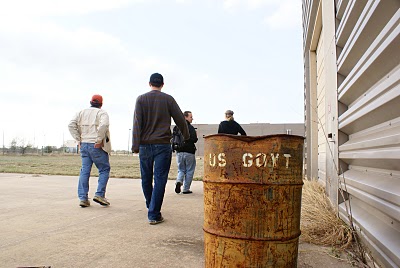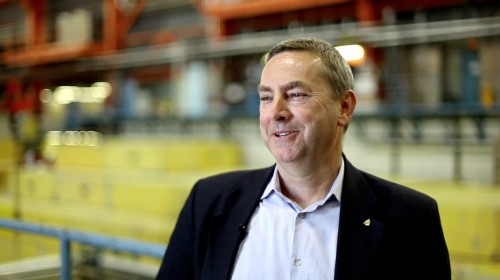Tag archives: Fermilab
Rebirth of the SSC?

Physicists entering the derelict site of the Superconducting Super Collider in 2011.
By Michael Banks
Following the closure of Fermilab’s 1 TeV Tevatron particle collider near Chicago in 2011 – and with no similar facility being planned to replace it in the US – many physicists in the country felt not surprisingly concerned that America was losing its place at the “energy frontier”. That baton had already passed to the CERN particle-physics lab near Geneva when its Large Hadron Collider (LHC) fired up in 2008, and with collisions set to restart there next year at 13 TeV, the US’s day looked certain to have passed.
View all posts by this author | View this author's profile
Nigel Lockyer to take the reins at Fermilab

TRIUMF’s Nigel Lockyer will soon be Chicago bound. (Courtesy: TRIUMF)
By Hamish Johnston
The particle physicist Nigel Lockyer will take over as director of Fermilab in September this year. Lockyer is currently in charge of TRIUMF in Vancouver, Canada. He will succeed Pier Oddone, who is stepping down after heading Fermilab for eight years.
View all posts by this author | View this author's profile
First light at the NOvA neutrino detector

Burst of particles created when a muon interacts with the NOvA Far Detector. (Courtesy: NOvA collaboration)
By Hamish Johnston
Deep in the North Woods in Minnesota the snow is starting to melt, and the giant NOvA Far Detector is coming to life. Designed to register the arrival of neutrinos that will be created 810 km away at Fermilab near Chicago, the detector has recorded its first 3D images. These are not of neutrinos, but of the trajectories of fast-moving particles that are created in a process that begins with a cosmic ray colliding with Earth’s atmosphere.
View all posts by this author | View this author's profile
CDF bump almost gets a five-star rating

The graph shows the distribution of the “w-jj excess” as seen by the CDF experiment (Courtesy: Punzi/Fermilab)
By Tushna Commissariat
Two months ago, in early April, the particle-physics community was rife with speculation and excitement over a “bump” – a possible new particle – in the data that Fermilab’s CDF experiment was looking at. On Monday 30 May Giovanni Punzi, a CDF collaborator, presented an update on what is now referred to the “ W-jj” bump, as a part of his talk at the 23rd Rencontres de Blois Particle Physics and Cosmology conference currently being held in France. The update says that the bump is seen in more recent data with an even larger statistical significance.
At the time, CDF was looking for slightly rare di-boson pairs – W bosons produced in association with another W or a Z boson. It noted a bump between 120 and 160 GeV /C2 in the jets produced in the collisions with a statistical significance of about “three-sigma”, which meant that the result would not be considered valuable until a “five-sigma” statistical significance could be established. The new data, however, have established a significance that is officially “closer to five sigma” (unconfirmed sources suggest it is as close as 4.8) and that “it was not just a statistical fluctuation” and that it is now a “serious issue for CDF to understand this”, according to Punzi.
Interestingly, Punzi’s slides also say that it is almost impossible that bump is due to the Standard Model top-quark background, as suggested by some theoretical papers, as that would imply that previous measurements for SM top-quark background had huge errors. The next step forward would be if CDF’s sister experiment D0 or the LHC’s ATLAS or CMS experiments, none of which have found the bump in their data so far, manage to detect it.
This updated result has seen a variety of responses from physicists.
Adam Falkowski, who writes the Resonaances blog, seems rather jubilant. “In a collider experiment, such a huge departure from a Standard Model prediction is happening for the first time in the human history,” he writes. “I don’t have to stress how exciting it is.”
Peter Woit, author of the Not Even Wrong blog, feels that while a five-sigma significance is important, problems with background modelling might thwart the result. “The signal is being extracted from a huge background, so a small misunderstanding of the background could be its cause.” Only a detection of the same result by another experiment would make the case more compelling, according to him.
Tommaso Dorigo, a blogger and CDF collaborator, is still sceptical of the result and chalks it up to bad background modelling, like Woit. “No, it is not the Higgs. And it is not a new particle. It is, in my humble opinion, a problem in the modelling of backgrounds, one which was unnoticed before only because it is small enough to have escaped previous attempts at “tuning” the simulations.”, he writes in his blog.
So while it seems like we the path to “new physics” is full of “bumps”, the field of particle physics is a rather exciting one right now! Take a look at the slides Punzi used for his talk here.
View all posts by this author | View this author's profile